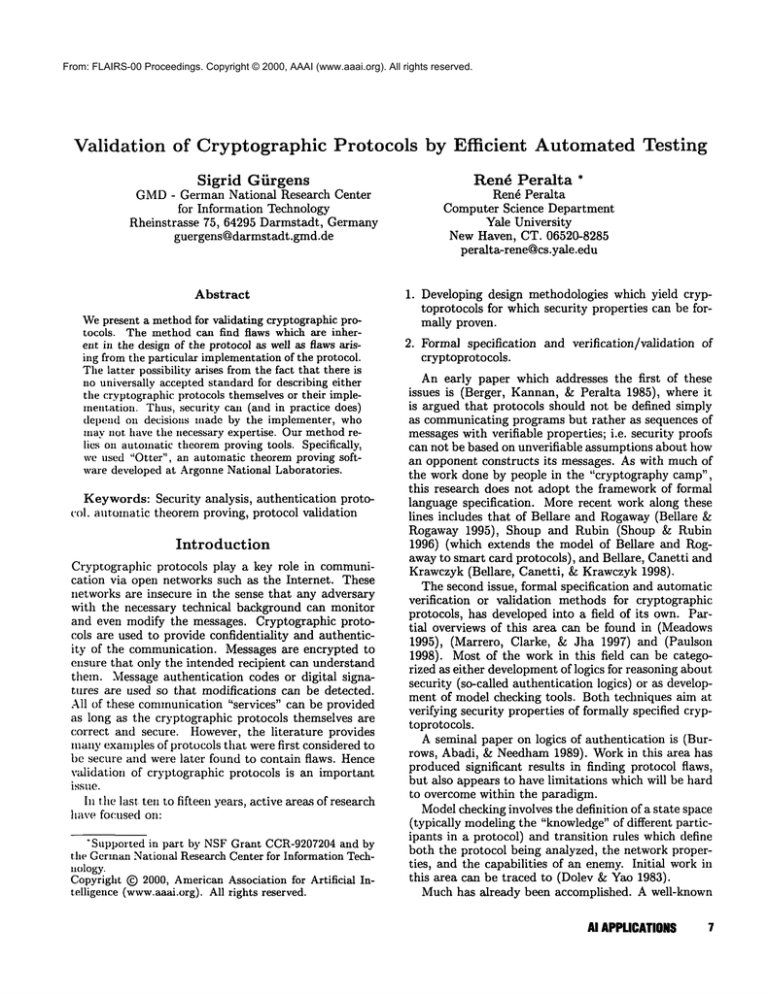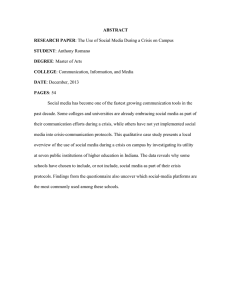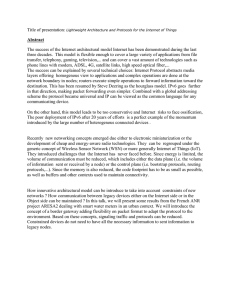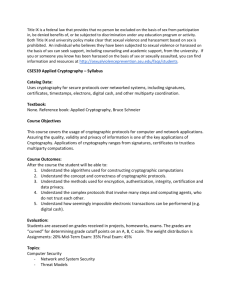
From: FLAIRS-00 Proceedings. Copyright © 2000, AAAI (www.aaai.org). All rights reserved.
Validation
of Cryptographic
Protocols
by Efficient
Automated Testing
Sigrid Giirgens
Ren@Peralta *
GMD- German National Research Center
for Information Technology
Rheinstrasse 75, 64295 Darmstadt, Germany
guergens@darmstadt.gmd.de
Ren@Peralta
Computer Science Department
Yale University
New Haven, CT. 06520-8285
peralta-rene@cs.yale.edu
Abstract
Wepresent a methodfor validating cryptographic protocols. The methodcan find flaws which are inherent i~l the design of the protocol as well as flaws arising from the particular implementationof the protocol.
Thelatter possibility arises fromthe fact that there is
no universally accepted standard for describing either
the cryptographic protocols themselves or their implementation. Thus, security call (and in practice does)
depend on decisions made by tlm implementer, who
maynot have the necessary expertise. Our methodrelics on automatic theoremproving tools. Specifically,
wc used "Otter", an automatic theorem proving software developed at ArgonneNational Laboratories.
Keywords: Security analysis, authentication protocol. automatic theorem proving, protocol validation
Introduction
Cryptographic protocols play a key role in communication via open networks such as the Internet. These
networks are insecure in the sense that any adversary
with the necessary technical background can monitor
and even modify the messages. Cryptographic protocols are used to provide confidentiality and authenticity of the communication. Messages are encrypted to
ensure that only the intended recipient can understand
them. Message authentication codes or digital signatures are used so that modifications can be detected.
All of these communication "services" can be provided
as long as the cryptographic protocols themselves are
correct and secure. However, the literature provides
manyexamples of protocols that were first considered to
be secure and were later found to contain flaws. Hence
validation of cryptographic protocols is an important
issue.
In the last ten to fifteen years, active areas of research
have fo(:used on:
"Supported in part by NSFGrant CCR-9207204and by
the GermanNational Research Center for Information Technology.
Copyright (~) 2000, AmericanAssociation for Artificial Intelligence (www.aaai.org).All rights reserved.
1. Developing design methodologies which yield cryptoprotocols for which security properties can be formally proven.
2. Formal specification
cryptoprotocols.
and verification/validation
of
An early paper which addresses the first of these
issues is (Berger, Kannan, & Peralta 1985), where
is argued that protocols should not be defined simply
as communicating programs but rather as sequences of
messageswith verifiable properties; i.e. security proofs
can not be based on unverifiable assumptions about how
an opponent constructs its messages. As with much of
the work done by people in the "cryptography camp",
this research does not adopt the framework of formal
language specification.
More recent work along these
lines includes that of Bellare and Rogaway(Bellare
Rogaway 1995), Shoup and Rubin (Shoup & Rubin
1996) (which extends the model of Bellare and Rogaway to smart card protocols), and Bellare, Canetti and
Krawczyk (Bellare, Canetti, & Krawczyk 1998).
The second issue, formal specification and automatic
verification or validation methods for cryptographic
protocols, has developed into a field of its own. Partial overviews of this area can be found in (Meadows
1995), (Marrero, Clarke, & Jha 1997) and (Paulson
1998). Most of the work in this field can be categorized as either developmentof logics for reasoning about
security (so-called authentication logics) or as development of model checking tools. Both techniques aim at
verifying security properties of formally specified cryptoprotocols.
A seminal paper on logics of authentication is (Burrows, Abadi, & Needham1989). Work in this area has
produced significant results in finding protocol flaws,
but also appears to have limitations which will be hard
to overcome within the paradigm.
Modelchecking involves the definition of a state space
(typically modelingthe "knowledge"of different participants in a protocol) and transition rules which define
both the protocol being analyzed, the network properties, and the capabilities of an enemy. Initial work in
this area can be traced to (Dolev & Yao 1983).
Much has already been accomplished. A well-known
AI APPLICATIONS 7
software tool is the NRLProtocol Analyzer (Meadows
1991). l Other promising work includes Lowe’s use of
the Failures Divergences Refinement Checker in CSP
(Lowe 1996); Sehneider’s use of CSP (Schneider 1997);
the model checking algorithms of Marrero, Clarke, and
.lira (Marrero, Clarke, &Jha 1997); Paulson’s use of induction and the theorem prover Isabelle (Paulson 1998);
and the work of Heintze and Tygar considering compositions of cryI)toprotocols (Heintze & Tygar 1994).
As far as we know, the model checking approach has
been used almost exclusively for verification of cryptoprotocols. \~rification can be achieved efficiently if
siml)lif~’ing assumptious are made in order to obtain
sulti(’i,.ntly small stat.c space. Verification tools which
,’an han(lh, infinite state spaces must simplify the not ions of s(,(:urity and correctness to the point that proofs
,’ml I)(, ol)taine(1 using induction or other logical tools
to reason about infinitely many states. Both methods
hay(: produced valuable insight into ways in which cryptOln’OtO(:ols can fail. The problem, however, is not only
complex but also evolving. The early work centered
around proving security of key-distribution protocols.
Currently, it is fair to say that other, muchmore complex protocols, are being deployed in E-commerceapplications without the benefit of comprehensivevalidation.
In this paper we present a validation without verification approach. That is, we do not attempt to formally
prove that a protocol is secure. Rather, our tools are designed to find flaws in cryptoprotocols. Wereason that
by not attempting the very difficult task of proving security and correctness, we can produce an automated
tool that is good at finding flaws when they exist. We
use the theorem prover Otter (see (Wos et al. 1992))
our search engine. Someof the results we have obtained
t.o date are presented in the following sections.
Cryptographic
protocols
Iu what f, Jllows, we restrict ourselves to the study of
key-distribution protocols. The participants of such a
protocol will be called "agents". Agents are not nec,’ssarily people. They can be, for example, computers
acting autonomously or processes in an operating system. In general, the secrecy of cryptographic keys cannot I)e assumed to last forever. Pairs of agents nmst
p,,riodi(’all.v repla(:e their keys with newones. Thusthe
aim of a key-distribution protocol is to produce and securely distribute what are called "session" keys. This
is often achieved with the aid of a trusted key distribution server S (this is the mechanismof the widely used
Kerberos System).
The general format of these protocols is the following:
¯ Agent A wants to obtain a session key for communicating with agent B.
I The work in (Meadows& Syverson [998) expands NRL
to include somespecification capabilities. The resulting tool
W~L~
powerful enough to analyze the SETprotocol used by
Mastercard and Visa (Mastercard and VISA1996).
8
FLAIRS-2000
¯ It then initiates a protocol which involves S, A,
and B.
¯ The protocol involves a sequence of messages
which, in theory, culminate in A and B sharing
a key gAB.
¯ The secrecy of KABis supposed to be guaranteed
despite the fact that all communication occurs
over insecure channels.
To illustrate the need for security analysis of such
protocols we describe a protocol introduced in (Needham & Schroeder 1978) and an attack on this protocol
first shown in (Denning & Sacco 1982). In what follows, a message is an ordered tuple (ml,m2,...,mr)
of concatenated message blocks m/, viewed at an abstract level where the agents can distinguish between
different blocks. The notation {m}g denotes the encryption of the message m using key K. The notation
n. A ~ B : m denotes that in step n of a protocol
execution (which we will call a protocol run throughout this paper) A sends message m to B. The protocol assumes that symmetric encryption and decryption
functions are used (where encryption and decryption
are performed with the same key).
1.
2.
3.
4.
5.
A ~ S :
S ~ A :
A
~B:
B
~ A:
A
)B
A,B, RA
{RA, B, gAB, {gAB, A}K.s }gAs
{KAB,A}Kes
{RB}Ka,
{RB--1}KAB
In the first message agent A sends to S its name A,
the name of the desired communication partner (B) and
a random number RA which it generates for this protocol run. 2 S then generates a ciphertext for A, using
the key KAS that it shares with A. This ciphertext
includes A’s random number, B’s name, the new key
KAB, and a ciphertext intended for B. The usage of
the key gas shall prove to agent A that the message
was generated by S. The inclusion of RA ensures A
that this ciphertext and in particular the key gAB is
generated after the generation of RA, i.e. during the
current protocol run. Agent A also checks that the ciphertext includes B’s name, making sure that S sends
the new key to B and not to someone else, and then
forwards {KAB, A}K~s to B.
For B the situation is slightly different, as it learns
from A’s name who it is going to share the new key
with, but nothing in this ciphertext can prove to B
that this is indeed a new key. According to the protocol
description in (Needham & Schroeder 1978) this shall
be achieved with the last two messages: The fact that
B’s random number RB-- 1 is enciphered using the key
gABshall convince B that this is a newly generated key.
2In this paper, "random numbers"are abstract objects
with the property that they cannot be generated twice and
they cannot be predicted. It is not trivial to implement
these objects, and protocol implementations mayvery well
fail because the properties are not met. However,tackling
this problemis beyondthe scope of this paper.
However,there is a well-known attack on this protocol,
first shown in (Denning & Sacco 1982), which makes
clear ttmt this conclusion can not be drawn. In fact,
all that B can deduce fronl message 5 is that the key
A’.LI~ is used by someone other than B in the current
proto(’ol run.
TI~e attack assumes that an eavesdropper E monitors
ore, run of the protocol and stores {KAB, A}KBs. Since
wr assume the secrecy of agents’ keys holds only for a
limited time period, we consider the point at which E
gets to know the key I(AB. Then it can start a new
protocol run with B by sending it the old ciphertext
{KAB, A}g~s as message 3. Since B has no means to
notice that this is an old ciphertext, it proceeds according to the protocol description above. After the protocol run has finished, it believes that it shares gABas a
new session key with A, when in fact it shares this key
with E.
There is no way to repair this flaw without changing
the nmssages of the protocol if we do not want to make
the (unrealistic) assumption that B stores all keys
ever used. So, this is an example of a flaw inherent in
the i)rotocol design.
Another type of flaw can be due to the underspecification of a cryptoprotocol. Manyprotocol descriptions are vague about what checks are to be per[orm(’d by the recipient of a message. Thus, a protocol
imph,m,,ntation may be secure or insecure depending
cx(’lusiv(fly on whether or not a particular check is performed.
The
communication
and
attack
model
The security analysis of protocols does not deal with
weaknesses of the encryption and decryption functions
used. In what follows we assume that the following
security properties hold:
1. Messages encrypted with a secret key K can only be
-1.
decrypted with the inverse key K
2. A key can not be guessed.
3. Given m, it is not possible to find the corresponding ciphertext for any message containing m without
knowledge of the key.
Wtfile the first two items describe generally accepted
properties of encryption functions, the last one which
Boyd called tim "cohesive property" in (Boyd 1990)
does not hold in general. Boyd and also Clark and Jacot) (see (Clark & Jacob 1995)) show that under certain
(’(mditions, t)articular modesof somecryptographic
gorithms allow the generation of a ciphertext without
knowledge of the key.
These t)al)ers were important in that they drew attention to hidden cryptographic assumptions in "proofs" of
security of cryptoprotocols. In fact, it is clear nowthat
the mmfl)er (and types) of hidden assumptions usually
present in security proofs is much broader than what
Boyd and Clark and Jacob point out.
(
Figure 1: The communication model.
All communication is assumed to occur over insecure
communication channels. What an insecure communication channel is can be defined in several ways. In our
model we assume that there is a third agent E with the
ability to intercept messages. After intercepting, E can
change the message to anything it can compute. This
includes changing the destination of the message and
the supposed identity of the sender. Furthermore, E
is considered a valid agent, thus also shares a symmetric key KES 1)
with S and/or owns a key pair (K~, K~
for an asymmetric algorithm, and is allowed to initiate
communication either with other agents or S. Figure 1
depicts our communication model.
E intercepts all messages and the agents and S only
receive messages sent by E. What E can send depends
on what it is able to generate, and this in turn depends
on what E knows.
The knowledge of E can be recursively defined as
follows:
1. E knows the names of the agents.
2. E knows the keys it owns.
3. E knows every message it has received.
4. E knows every part of a message received (where
ciphertext is considered one message part).
5. E knows everything it can generate by enciphering
data it knows using data it knows as a key.
6. E knows every plaintext it can generate by deciphering a ciphertext it knows, provided it knows the inverse of the key used as well.
7. E knows every concatenation of data it knows.
8. E knows the origin and destination of every message.
9. At every instance of the protocol run, E knows the
"state" of every agent, i.e. E knowsthe next protocol
step they will perform, the structure of a message
necessary to be accepted, what they will send after
having received (and accepted) a message, etc.
At every state in a possible run, after having received
an agent’s message, E has the possibility to forward
this message or to send whatever message it can generate to one of the agents or S. Obviously, the state
AI APPLICATIONS 9
space will grow enormously. Thus, we must limit the
concept of knowledgeif the goal is to produce a validation tool which can be used in practice. Therefore we
restrict the definition in various ways in order to make
E’s knowledgeset finite. For example, we do not allow
E to know ciphertexts of level 3 (e.g. {{{m}K}K}K).
Wedo this on an ad-hoc basis. This problem needs
further exploration. 3
Note that the above knowledge rules imply that E
never forgets. In contrast, the other agents forget everything which they are not specifically instructed to
r(~memberby the t)rotocol description.
Automatic
testing
of protocol
instantiations
As the title of this section suggests, we makea distinction between a protocol and a "protocol instantiation".
W,, deemthis a necessary distinction because protocols
in the literature are often under-specified. A protocol
may l)c implenmnted in any of several ways by the applications programmer.
Otter is based on first order logic. Thusfor describing
the protocol to be analyzed, the environment, and the
possible state transitions, we use first order functions,
predicates, implications and the usual connectives. At
any step of a protocol run, predicates like
state( xevents, xE knows,. . . , xwho,xto, xmess, . . .)
are used to describe the state of the protocol run given,
the list xevents of actions already performed and the
list xEk’nows of data knownby E. These predicates are
also used to describe the states of the agents (e.g. data
like session keys, nonces, etc. the agents have stored
so far for later use, the protocol runs they assume to
be taking part in, and the next step they will perform
in each of these runs). In general the predicates can
include as manyagents’ states and protocol runs as desired, but so far we have restricted this information to
agents A, B, E and S in the context of two interleaving protocol runs. Furthermore, the predicates contain,
amongother data used to direct the search, the agent
x who which sent the current message, the intended re(:ipieIlt xto and the messagexmess sent.
Using these predicates we write formulas which describe possible state transitions. The action of S when
receiving message1 of the protocol described in the second section can be formalized as follows:
sees( xevents, x E knows, . . . , xwho, xto, xmess.... )
A xto = S
A is_agent(el(l, xmess))
A is_agent(el(2, xmess))
.-+
send(update(xevents), xEknows.... , S, el(l, xmess),
3~Ve note, however,that leaving this part of our model
open allows for a very general tool. This is in part responsible for the success of the tool, as documented
in later sections.
10
FLAIM-2000
[enc(key(el(1, xmess), [el( 3, xmess),
el(2, xmess), new_key, enc( key(el( 2, xmess),
[new_key,
el(l, xmess) ] ) ] ) ], . .
where update(xevents) includes the current send action
and el(k, xmess) returns the kth block of the message
xmess just received.
Whenever E receives
a message (indicated
by a formula sees_E(...)),
an internal
procedure adds all that E can learn from the message to the knowledge list xEknows.
Implications sees_E(...)
--~ send_E(...,messagel,...)
send_E(...,message2,...)
A... formalize that after
having received a particular message, E has several
possibilities to proceed with the protocol run, i.e. each
of the predicates send_E(..., message,...) constitutes
a possible continuation
of the protocol run. The
messages E sends to the agents are constructed using
the basic data in xEknowsand the specification of E’s
knowledgeas well as some restrictions as discussed in
the previous section.
Weuse equations to describe the properties of the encryption and decryption functions, the keys, the nonces
etc.. For example, the equation
dec(x, enc(x, y) )
formalizes symmetric encryption and decryption functions where every key is its own inverse. These equations are used as demodulators in the deduction process.
The above formulas constitute the set of axioms describing the particular protocol instantiation to be analyzed. Anadditional set of formulas, the so-called "set
of support", includes formulas that are specific for a
particular analysis. In particular, we use a predicate
describing the initial state of a protocol run (the agent
that starts the run, the initial knowledgeof the enemy
E, etc.) and a formula describing a security goal. An
example of such a formula is "if agents A and B share
a session key, then this key is not knownby E".
Using these two formula sets and logical inference
rules (specifically, we makeextensive use of hyper resolution), Otter derives new valid formulas which correspond to possible states of a protocol run. The process stops if either no more formulas can be deduced
or Otter finds a contradiction which involves the formula describing the security goal. Whenhaving proved
a contradiction, Otter lists all formulas involved in the
proof. An attack on the protocol can be easily deduced
fromthis list.
Otter has a number of facilities
for directing the
search, for a detailed description see (Woset al. 1992).
Known and new attacks
Weused Otter to analyze a number of protocols. Whenever we model a protocol we are confronted with the
problem that usually the checks performed by the parties upon receiving the messages are not specified completely. This means that we must place ourselves in
the situation of the implementer and simply encode the
obvious checks. For example, consider step 3 of the
Needham-Schroeder protocol explained in the second
section.
3.
A ~ B : {KAB,A}KBs
Here is a case where we have to decide what B’s
checks are. Wedid the obvious:
¯ B decrypts
using KBs.
¯ B checks that the second component of the decrypted
message is some valid agent’s name.
¯ B assumes, temporarily, that the first component of
the decrypted message is the key to be shared with
this agent.
To our great surprise,
Otter determined
that this was a fatal flaw in the implementation.
Wecall the type of attack found the "arity" attack,
since it depends on an agent not checking the number
of message blocks embeddedin a cyphertext. The arity
attack found by Otter works as follows: in the first
message E impersonates B (denoted by EB) and sends
to S:
1. EB ~ S: B,A, RE
Then, S answers according to the protocol description
and sends the following message to B:
2. S ) B: {RE, A, KAB,{KAB,B}KAs}KBs
This is passed on by E, and B interprets it as being the
third message of a new protocol run. Since this message
passes the checks described above, B takes RE to be a
new session key to be shared with A and the last two
prot, otol steps are as follows:
4. B ~EA: {R~}RE
5. EA ) B: {RB- 1}R~
where tile last message can easily be generated by E
since it knowsits randomnumber sent in the first protocol step (see (Gfirgens &Peralta 1999) for a formalization of B’s actions).
It is interesting to note that an applications programrner is quite likely to not include an "arity-check" in the
code. This is because modular programming naturally
leads to the coding of routines of the type
get ( cyphertext, key, i)
which decodes cyphertext with key and returns the th
i
element of the plaintext.
By including the arity check in B’s actions when receiving message 3, we analyzed a different instantiation of the same protocol. This time Otter found the
Denning-Sacco attack.
It seems that many protocols may be subject to the
"’arit.y" attack: our methodsfound that this attack is
also possible on the Otway-Reesprotocol (see (Gfirgens
£: Peralta 1999) for a detailed description of the protocol and its analysis) and on the Yahalomprotocol, as
described in (Burrows, Abadi, & Needham1989).
Furthermore, we analyzed an authentication protocol
for smartcards with a digital signature application being standardized by the Germanstandardization organisation DIN ((DIN NI-17.4 1998)) and found the
posed standard to be subject to some interpretations
which would make it insecure (see (G/irgens, Lopez,
Peralta 1999)).
Among the known attacks which were also found
by our methods are the Lowe ((Lowe 1996)) and
Meadows (Meadows 1996) attacks on the NeedhamSchroeder public key protocol and the Simmonsattack
on the TMNprotocol (see (Tatebayashi, Matsuzaki,
Newman1991)). The latter is noteworthy since this
attack uses the homomorphismproperty of some asymmetric algorithms.
Conclusions
As is well known, there does not exist an algorithm
which can infallibly decide whether a theorem is true
or not. Thus the use of Otter, and per force of any theorem proving tool, is an art as well as a science. The
learning curve for using Otter is quite long, which is a
disadvantage. Furthermore, one can easily write Otter
input which would simply take too long to find a protocol failure even if one exists and is in the search path of
Otter’s heuristic. Thus, using this kind of tool involves
the usual decisions regarding the search path to be followed. Nevertheless, our approach has shown itself to
be a powerful and flexible way of analyzing protocols.
In particular,
our methods found protocol weaknesses
not previously found by other formal methods.
We do not yet have a tool which can be used by
applications programmers. Analyzing protocols with
our methods requires some expertise in the use of Otter
as well as some expertise in cryptology. Although it is
clear that much of what we now do can be automated
(e.g. a compiler could be written which maps protocol
descriptions to Otter input); it is not clear how much
of the search strategy can be automated.
Our work with Otter has led us to the conclusion that
it is not sufficient to ask protocol designers to follow
basic design principles in order to avoid security flaws.
One reason for this is that those principles might not
be appropriate for particular applications (e.g. security considerations in smart card applications are quite
different from, say, security considerations in network
applications). Adherence to some basic design principles, although a good idea, will not guarantee security
in the real world. The new attack we found on the
Needham-Schroeder protocol, for example, would not
be prevented by using additional messagefields to indicate the direction of a message. Our methodology can
be useful for deciding what implementation features are
necessary in a particular environment for a given protocol to be secure.
AI APPLICATIONS11
References
Bellare, M., and Rogaway, P. 1995. Provably secure
session key distribution - the three party case. In Annual Symposium on the Theory of Computing, 57-66.
ACM.
Bellare, M.; Canetti, R.; and Krawczyk, H. 1998. A
Modular Approach to the Design and Analysis of Authentication and Key Exchange Protocols. In Annual
Symposium on the Theory of Computing. ACM.
Berger, R.; Kannan, S.; and Peralta, R. 1985. A
framework for the study of cryptographic protocols.
Ill Advances in Cryptology - CRYPTO’95, Lecture
Note.s in Computer Science, 87-103. Springer-Verlag.
B~)’rl. C. 1990. Hidden assumptions in cryptographic
protocols. In IEEE Proceedings, volume 137, 433-436.
Burrow.~, M.: Abadi, M.; and Needham, R. 1989. A
Logi(’ of Authentication. Report 39, Digital Systems
R(:scarch Center, Palo Alto, California.
Clark, J., and Jacob, J. 1995. On the Security of Rec(,nt Protocols. Information Processing Letters 56:151155.
Denning, D., and Sacco, G. 1982. Timestamps in key
distribution
protocols. Communications of the ACM
24:533-536.
DIN NI-17.4. 1998. Spezifikation der Schnittstelle
zu Chipkarte’n mit Digitaler Signatur-Anwendung /
Funktion nach SigG und SigV, Version 1.0 (Draft).
Dolev, D., and Yao, A. 1983. On the security of
1)ublic-key protocols. IEEE Transactions on Information Theory 29:198-208.
Giirgens, S., and Peralta, R. 1999. Efficient Automated Testing of Cryptographic Protocols. Technical Report 45-1998, GMDGerman National Research
Center for Information Technology.
Giirgcns, S.; Lopez, J.; and Peralta, R. 1999. Efficient
Detoction of Failure Modes in Electronic Commerce
Protocols. In DEXA’99 lOth International Workshop
on Database and Expert Systems Applications, 850857. IEEE Computer Society.
Hcintze, N., and Tygar, J. 1994. A Model for Secure Protocols and their Compositions. In 1994 IEEE
Comlrater Society Symposium on Research in Security
and Privacy, 2-13. IEEE Computer Society Press.
Lowc, G. 1996. Breaking and fixing the NeedhamSchroeder tmblic-key protocol using CSPand FDR. In
S¢:co’nd International Workshop, TA CAS ’96, volume
1055 of LNCS, 147-166. SV.
Marrero, W.; Clarke, E. M.; and Jha, S. 1997. A Model
Checker for Authentication
Protocols. In DIMACS
Workshop on Cryptographic Protocol Design and Veri, fication.
1996. Mastercard
and VISA Corporations,
Secure Electronic Transactions (SET) Specification.
http://www.setco.org.
12
FLAIRS-2000
Meadows, C., and Syverson, P. 1998. A formal specification of requirements for payment transactions in
the SET protocol. In Proceedings o/Financial Cryptography.
Meadows,C. 1991. A system for the specification and
verification
of key management protocols. In IEEE
Symposium on Security and Privacy, 182-195. IEEE
Computer Society Press, NewYork.
Meadows, C. 1995. Formal Verification
of Cryptographic Protocols: A Survey. In Advances in Cryptology - Asiacrypt ’9~, volume 917 of LNCS, 133 - 150.
SV.
Meadows, C. 1996. Analyzing the Needham-Schroeder
Public Key Protocol:
A Comparison of Two Approaches. In Proceedings of ESORICS.Naval Research
Laboratory: Springer.
Needham, R., and Schroeder, M. 1978. Using encryption for authentication in large networks of computers.
Communications of the A CM993-999.
Paulson, L. C. 1998. The inductive approach to verifying cryptographic protocols. Journal of Computer
Security 6:85-128.
Schneider, S. 1997. Verifying authentication protocols
with CSP. In IEEE Computer Security Foundations
Workshop. IEEE.
Shoup, V., and Rubin, A. 1996. Session key distribution using smart card. In Advances in Cryptology
- EUROCRYPT
’96, volume 1070 of LNCS, 321-331.
SV.
Tatebayashi, M.; Matsuzaki, N.; and Newman.1991.
Key Distribution Protocol for Digital Mobile Communication Systems. In Brassard, G., ed., Advances in
Cryptology - CRYPTO’89, volume 435 of LNCS, 324333. SV.
Wos, L.; Overbeek, R.; Lusk, E.; and Boyle, J. 1992.
Automated Reasoning - Introduction and Applications.
McGraw-Hill, Inc.






